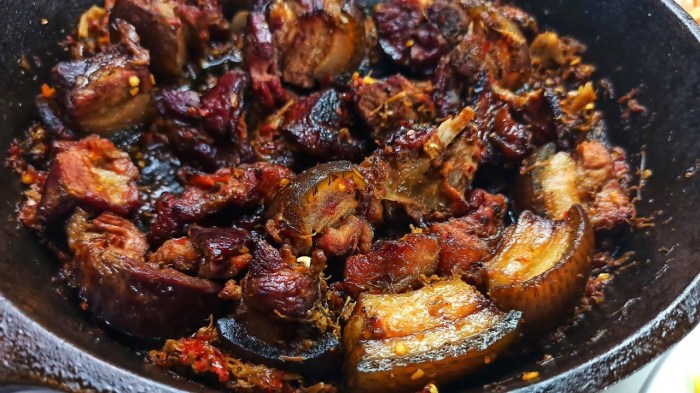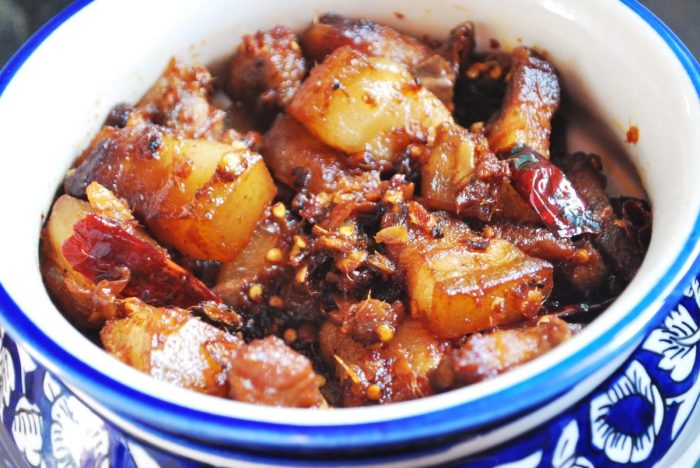How to cook smoked pork naga style – Literary criticism is the analysis and evaluation of literary works. It involves examining the themes, characters, writing style, and overall effectiveness of a piece of literature. In the case of cooking instructions, literary criticism can be applied to dissect the language and techniques used to convey the process of preparing a dish.
Tips for Cooking Smoked Pork Naga Style
When embarking on the culinary journey of preparing smoked pork Naga style, it is essential to consider a few key tips to ensure a successful outcome. Firstly, it is crucial to source high-quality pork that is suitable for smoking. Secondly, marinating the pork in a flavorful mixture of spices and seasonings will enhance the taste and tenderness of the meat.
Lastly, paying attention to the smoking process and maintaining the right temperature will result in perfectly cooked smoked pork Naga style.
What Do You Mean by Smoked Pork Naga Style?: How To Cook Smoked Pork Naga Style
Smoked pork Naga style refers to a traditional dish from the Naga tribe in northeastern India. The dish involves marinating pork in a blend of local spices and seasonings before smoking it over a wood fire. This cooking method imparts a distinct smoky flavor to the pork, making it a beloved delicacy in Naga cuisine.
What is Known About Smoked Pork Naga Style?

Smoked pork Naga style is known for its rich and robust flavor profile. The combination of aromatic spices and the smoky essence from the smoking process creates a unique taste that is both savory and satisfying. Additionally, the slow cooking method results in tender and juicy pork that is perfect for serving as a main dish or incorporating into other recipes.
Solution for Cooking Smoked Pork Naga Style
To successfully cook smoked pork Naga style, it is important to follow a few key steps. Start by marinating the pork in a mixture of spices such as garlic, ginger, turmeric, and chili powder. Allow the meat to absorb the flavors for several hours or overnight. Next, prepare a wood fire for smoking and place the marinated pork over the heat source.
Let the pork smoke slowly until it is cooked through and has developed a deep, smoky flavor. Finally, slice the smoked pork and serve it hot with rice or other accompaniments.
Detail Information on Cooking Smoked Pork Naga Style
The process of cooking smoked pork Naga style involves a combination of marinating, smoking, and slow cooking to achieve the desired taste and texture. The use of traditional Naga spices such as bamboo shoot, akhuni, and bhut jolokia adds depth and complexity to the dish. The smoking process can take several hours, depending on the size of the pork and the intensity of the heat.
It is essential to monitor the temperature and adjust the smoking time accordingly to ensure that the pork is cooked evenly and thoroughly.
In modern life, cooking bitter melon Punjabi style can add a unique twist to your culinary skills. If you’re curious about how to prepare this dish, check out this helpful guide on how to cook bitter melon Punjabi style for a flavorful experience.
Describe in Depth the Preparation of Smoked Pork Naga Style

To prepare smoked pork Naga style, begin by selecting a cut of pork that is suitable for smoking, such as pork shoulder or ribs. Trim excess fat from the meat and cut it into manageable pieces for marinating. Create a spice mixture using a combination of local spices and seasonings, adjusting the quantities to suit your taste preferences. Rub the spice mixture onto the pork and let it marinate for at least a few hours, preferably overnight.
Next, set up a wood fire for smoking the pork. Use a smoking rack or grill to place the marinated pork over the heat source, ensuring that it is not too close to the flames. Allow the pork to smoke slowly, adding more wood chips or charcoal as needed to maintain a consistent temperature. The smoking process can take several hours, during which time the pork will absorb the smoky flavors and become tender and flavorful.Once the pork is fully cooked, remove it from the heat and let it rest for a few minutes before slicing and serving.
Are you looking to learn how to cook bitter melon Punjabi style? Check out this amazing recipe guide on how to cook bitter melon Punjabi style for a delicious and flavorful dish that you can enjoy with your family and friends.
Smoked pork Naga style pairs well with steamed rice, pickles, and fresh vegetables for a complete and satisfying meal.
Conclusion
In conclusion, cooking smoked pork Naga style is a time-honored tradition that involves a careful balance of flavors, techniques, and patience. By following the tips and steps Artikeld in this article, you can create a delicious and authentic dish that pays homage to the culinary heritage of the Naga tribe. Whether you are a seasoned chef or a novice cook, experimenting with smoked pork Naga style is sure to delight your taste buds and impress your guests.
FAQs
1. Can I use any type of pork for smoking Naga style?
Yes, you can use different cuts of pork such as shoulder, ribs, or loin for smoking Naga style. Just make sure to adjust the cooking time and temperature accordingly.
2. How long does it take to smoke pork Naga style?
The smoking process can take several hours, depending on the size of the pork and the intensity of the heat. It is important to monitor the temperature and adjust the smoking time as needed.
3. What spices are typically used in marinating smoked pork Naga style?
Traditional Naga spices such as garlic, ginger, turmeric, chili powder, bamboo shoot, akhuni, and bhut jolokia are commonly used in marinating smoked pork Naga style.
4. Can I serve smoked pork Naga style with other dishes?
Yes, smoked pork Naga style pairs well with steamed rice, pickles, and fresh vegetables. You can also incorporate it into other recipes such as stir-fries or curries.
5. Is smoked pork Naga style a spicy dish?, How to cook smoked pork naga style
Smoked pork Naga style can be spicy depending on the amount of chili powder and bhut jolokia used in the marinade. You can adjust the spice level to suit your taste preferences.
